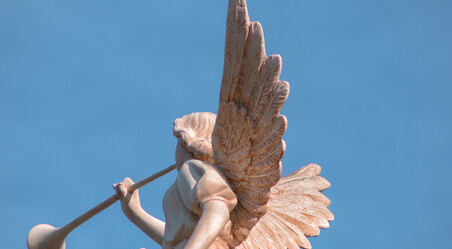Notes from Across the Atlantic
Peter Mitchell FAITH Magazine July – August 2011
John Paul: Living Witness to the Church
The first of May is not a national holiday on this side of the Atlantic, where we celebrate "Labor Day" on the first Monday of September. Thus the significance of the providential timing of the Beatification of Pope John Paul II may not have been as readily apparent to Americans as it was to the faithful in Great Britain and on the Continent. Yet once again, as occurred on the day of his death (2 April, 2005 was both the First Saturday of April and the vigil of Divine Mercy Sunday), the date chosen by God's Providence for the raising of Pope John Paul the Great to the altar contained many layers of significance. The unusually late date of Easter this year meant that Divine Mercy Sunday coincided with the first day of the month traditionally dedicated to the Blessed Mother, which is alsothe feast of Saint Joseph the Worker, the Church's response to communism's consecration of 1 May as its "high holy day" for celebrating workers. How fitting that the man who dedicated so much of his life to opposing the lie at the heart of communism's empty promises should be celebrated and remembered on communism's very own "feast day." The man who spent his early life as a worker behind the Iron Curtain became the instrument of the Holy Spirit in teaching the world about the true dignity of man, of human labour, and about the unfathomable power of Divine Mercy to transform evil into good, despair into hope, and oppression into freedom.
The lifelong aspiration of Karol Wojtyla was simply to be a servant of Mary, completely handed over to her Immaculate Heart, as expressed in his motto, "Totus Tuus." The fact that all of these streams of significance converged in St. Peter's Square on Divine Mercy Sunday, 1 May, 2011, was because, in the words of Pope Benedict's homily at the Mass of Beatification, "this is what was pleasing to the Lord."
Perhaps the most moving moment of the day came at the very beginning of the Mass, immediately following Pope Benedict's pronouncement of the formula of beatification, when the tapestry depicting the smiling face of the new Blessed was unveiled on the facade of St. Peter's Basilica. The crowd erupted with joy at that moment, as if John Paul II was again entering the Square in the Popemobile for a Mass or a Wednesday audience. But this time the shouts of joy contained an even deeper and richer significance: the man who by the witness of his life tirelessly proclaimed Jesus Christ to the whole world was now acknowledged to be in the presence of Christ in heaven, radiant in his holiness among the countless throng of blesseds and saints he himself had named over the course of his longpontificate.
Throughout the weekend of the beatification celebrations, Rome once again looked like it was in the midst of one of John Paul's World Youth Day celebrations. Along the cobblestone streets surrounding the Vatican, thousands of young people camped out in every direction, packed like sardines in the hope of getting into St. Peter's Square, or at least close by, for the Mass of Beatification. Once more the old familiar cheers of "Giovanni Paolo!" followed by a series of claps resounded through the Square, with an added "Santo Subito!" to boot. As they had for his funeral, the youth of the world came to Rome to give back to their spiritual father, to thank him by their presence for the way he has irrevocably affected their lives by telling them that the Church believes in them and that theThird Millennium desperately needs their courageous, joyful and radical witness to the Gospel.
"It was as if John Paul was back," said one young seminarian in attendance, acknowledging the particular charism of hope and enthusiasm which the Holy Spirit is continuing to pour upon the Church through the witness of Karol Wojtyla. Pope Benedict himself acknowledged this charism of vibrant hopefulness in his homily at the Mass of Beatification, saying that Blessed John Paul "directed Christianity once again to the future" and "rightly reclaimed for Christianity that impulse of hope which had in some sense faltered before Marxism and the ideology of progress."
John Paul "restored to Christianity its true face as a religion of hope," said Pope Benedict, and that contagious, overflowing hope was again made visible in St. Peter's Square and the streets of Rome during the celebration of the beatification of the one who was chosen by the Holy Spirit to lead the Church across the threshold of hope that is the dawn of the Third Millennium of Christianity. The cause of that hope is the fulfilment of every human longing in Jesus Christ, the Redeemer of Man -the enduring legacy of Blessed John Paul II is nothing else than Jesus Christ.
On a more personal note, the beatification of John Paul II has renewed my faith in and understanding of the communion of saints. I can say proudly that "I knew him when he was Pope!" I have attended World Youth Days with him, I have listened to his homilies, I have read his encyclicals, I entered the seminary at his urging...and now he has made it to the goal of eternal life in the kingdom of heaven. Blessed John Paul II remains my spiritual father, and he continues to guide and bless my life by his witness and intercession. Such confident hope was expressed by Pope Benedict at the conclusion of his homily that joyful morning: "Beloved Pope John Paul II ... continue, we implore you, to sustain from heaven the faith of God's people. You often blessed us in this Square from the ApostolicPalace: Bless us, Holy Father! Amen."






